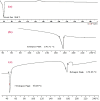Biodegradable m-PEG/PCL Core-Shell Micelles: Preparation and Characterization as a Sustained Release Formulation for Curcumin
- PMID: 25671181
- PMCID: PMC4312397
- DOI: 10.5681/apb.2014.074
Biodegradable m-PEG/PCL Core-Shell Micelles: Preparation and Characterization as a Sustained Release Formulation for Curcumin
Abstract
Purpose: Among the potent anticancer agents, curcumin is known as a very efficacious against many different types of cancer cells, but its clinical applications has been limited because of hydrophobicity, low gastrointestinal absorption, poor bioavailability and rapid metabolism. In this way, a novel micellar delivery system with mPEG-PCL was synthesized and the release profile of the curcumin from the drug-loaded micelles was evaluated.
Methods: In this study, curcumin was encapsulated within monomethoxypoly(ethylene glycol)-poly(ε-caprolactone) (mPEG-PCL) micelles through a single-step nano-precipitation method, leading to creation of curcumin-loaded mPEG-PCL (Cur/mPEG-PCL) micelles. Di-block mPEG-PCL copolymers were synthesized and used to prepare micelles. mPEG-PCL copolymer was characterized in vitro by HNMR, FTIR, DSC and GPC techniques. Then, mPEG-PCL copolymers with curcumin were self-assembled into micelles in aqueous solution. The resulting micelles were characterized further by various techniques such as dynamic light scattering (DLS) and atomic force microscopy (AFM).
Results: The findings showed the successful formation of smooth and spherical curcumin-loaded micelles. The encapsulation efficiency of curcumin was 88 ± 3.32%. The results of AFM revealed that the micelles have spherical shapes with size of 73.8 nm. The release behavior of curcumin from micelles was compared in different media. In vitro release of curcumin from curcumin-entrapped micelles was followed remarkably sustained profile. The sustained release of drug was hypothetically due to the entrapment of curcumin in core of micelles.
Conclusion: The results indicate the successful formulation of curcumin loaded m-PEG/PCL micelles. From the results, iIt can be concluded that curcumin m-PEG-PCL micelles may be considered as an effective treatment strategy for cancer in the future.
Keywords: Curcumin; Drug delivery; Micelles; mPEG-PCL.
Figures
Similar articles
-
Sulforaphane delivery using mPEG-PCL co-polymer nanoparticles to breast cancer cells.Pharm Dev Technol. 2017 Aug;22(5):642-651. doi: 10.3109/10837450.2016.1146296. Epub 2016 Feb 25. Pharm Dev Technol. 2017. PMID: 26916923
-
Pharmacokinetics and in vivo delivery of curcumin by copolymeric mPEG-PCL micelles.Eur J Pharm Biopharm. 2017 Jul;116:17-30. doi: 10.1016/j.ejpb.2016.10.003. Epub 2016 Oct 15. Eur J Pharm Biopharm. 2017. PMID: 27756682
-
Co-delivery of hydrophilic and hydrophobic drugs by micelles: a new approach using drug conjugated PEG-PCLNanoparticles.Drug Dev Ind Pharm. 2017 Nov;43(11):1908-1918. doi: 10.1080/03639045.2017.1355922. Epub 2017 Aug 3. Drug Dev Ind Pharm. 2017. PMID: 28737462
-
Scale-Up of the Manufacturing Process To Produce Docetaxel-Loaded mPEG-b-p(HPMA-Bz) Block Copolymer Micelles for Pharmaceutical Applications.Org Process Res Dev. 2019 Dec 20;23(12):2707-2715. doi: 10.1021/acs.oprd.9b00387. Epub 2019 Oct 29. Org Process Res Dev. 2019. PMID: 32952390 Free PMC article. Review.
-
Phosphatidylcholine (PCL) fortified nano-phytopharmaceuticals for improvement of therapeutic efficacy.EXCLI J. 2023 Aug 18;22:880-903. doi: 10.17179/excli2023-6345. eCollection 2023. EXCLI J. 2023. PMID: 38317861 Free PMC article. Review.
Cited by
-
Application of Non-Viral Vectors in Drug Delivery and Gene Therapy.Polymers (Basel). 2021 Sep 28;13(19):3307. doi: 10.3390/polym13193307. Polymers (Basel). 2021. PMID: 34641123 Free PMC article. Review.
-
Improving anti-melanoma effect of curcumin by biodegradable nanoparticles.Oncotarget. 2017 Aug 24;8(65):108624-108642. doi: 10.18632/oncotarget.20585. eCollection 2017 Dec 12. Oncotarget. 2017. PMID: 29312556 Free PMC article.
-
The impact of polymer coatings on magnetite nanoparticles performance as MRI contrast agents: a comparative study.Daru. 2015 Sep 17;23(1):45. doi: 10.1186/s40199-015-0124-7. Daru. 2015. PMID: 26381740 Free PMC article.
-
Preparation, characterisation, and controlled release of sex pheromone-loaded MPEG-PCL diblock copolymer micelles for Spodoptera litura (Lepidoptera: Noctuidae).PLoS One. 2018 Sep 7;13(9):e0203062. doi: 10.1371/journal.pone.0203062. eCollection 2018. PLoS One. 2018. PMID: 30192792 Free PMC article.
-
Resveratrol-Loaded Polymeric Nanoparticles: The Effects of D-α-Tocopheryl Polyethylene Glycol 1000 Succinate (TPGS) on Physicochemical and Biological Properties against Breast Cancer In Vitro and In Vivo.Cancers (Basel). 2023 May 17;15(10):2802. doi: 10.3390/cancers15102802. Cancers (Basel). 2023. PMID: 37345140 Free PMC article.
References
-
- Sun YM, Zhang HY, Chen DZ, Liu CB. Theoretical elucidation on the antioxidant mechanism of curcumin: a DFT study. Org Lett. 2002;4(17):2909–11. - PubMed
-
- Han S, Yang Y. Antimicrobial activity of wool fabric treated with curcumin. Dyes Pigments. 2005;64(2):157–61.
-
- Kohli K, Ali J, Ansari MJ, Raheman Z. Curcumin: a natural antiinflammatory agent. Ind J Pharmacol. 2005;37(3):141–7.
-
- Panchatcharam M, Miriyala S, Gayathri VS, Suguna L. Curcumin improves wound healing by modulating collagen and decreasing reactive oxygen species. Mol Cell Biochem. 2006;290(1-2):87–96. - PubMed
-
- Sun A, Shoji M, Lu YJ, Liotta DC, Snyder JP. Synthesis of EF24-tripeptide chloromethyl ketone: a novel curcumin-related anticancer drug delivery system. J Med Chem. 2006;49(11):3153–8. - PubMed
LinkOut - more resources
Full Text Sources
Miscellaneous









